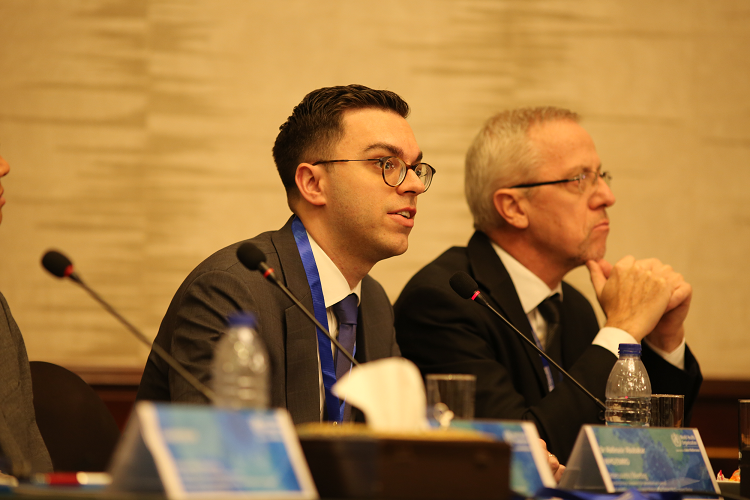An interview with Mr Christopher Chadwick, Technical Officer for Influenza Preparedness and Response at the World Health Organization.
 Mr Christopher Chadwick (l) at the recent Intercountry Meeting on the Strategic Framework for Prevention and Control of Emerging and Epidemic-prone Diseases (Photo: Simon van Woerden/WHO)
Mr Christopher Chadwick (l) at the recent Intercountry Meeting on the Strategic Framework for Prevention and Control of Emerging and Epidemic-prone Diseases (Photo: Simon van Woerden/WHO)
When you hear the word ‘pandemic’, what do you see? Likely some combination of millions of sick people and deaths, airports and borders closing, the international medical community in overdrive. Worldwide devastation. What about ‘influenza’? A runny nose, a few days in bed, no big deal. Right?
Wrong. The flu, especially new or ‘novel’ types of influenza for which people do not have any immunity yet, is nothing to take lightly. The risk of another pandemic like the 1918 Spanish flu, which killed between 20 and 50 million people, is not merely hypothetical. In fact, according to the World Health Organization (WHO) and infectious hazard experts, it is a statistical certainty: not a matter of ‘if’, but of ‘when’ and ‘how serious’. Besides future pandemics, the seasonal flu currently infects 1 billion people every year, including 3-5 million severe cases, and causes 290 000 to 650 000 respiratory deaths.
To address these and other flu-related challenges, WHO is announcing a new global influenza strategy, which will be launched this year and expire in 2030. With it, the health organization aims to “call on all countries and partners to prioritize the implementation of influenza programmes”. Mr Christopher Chadwick is a technical officer at WHO working on the new strategy. He agrees that the threat of influenza and the concern people seem to have, are mismatched. “Looking at the bigger picture, influenza has a bigger impact than some of the other infectious diseases that pop up. Seasonal flu impacts every single country, every single year, and although there are some specific high-risk groups - pregnant women, healthcare workers, people who are chronically ill or have a weakened immune system, children and elderly people - it really hits everyone.”
A partial explanation for the low risk perception is the confusion with the far more harmless common cold. Mr Chadwick: “We need to communicate better. Not just about influenza deaths but also about the milder cases that force people to miss work or school.” According to the new strategy, the economic cost associated with seasonal influenza ranges from US$30 to US$60 per capita.
If people underestimate the threat of influenza, the same goes for their governments. Mr Chadwick: “We also have to communicate to policymakers, because many countries do not see influenza as a priority. Especially when there are outbreaks of higher profile pathogens, like Ebola.” To better understand influenza’s relative health risk, policymakers need better information and data. The new strategy includes plans for this. It aims to improve surveillance and analysis on the burden which influenza places on a country and its economy - especially in lower- and middle-income countries. Mr Chadwick: “Understanding and showing the burden of disease is the first step in establishing an influenza programme.” The strategy also aims to strengthen scientific research, expand prevention and control programmes to protect vulnerable groups, and strengthen pandemic preparedness and response.
The last point carries special weight. After the outbreak of pandemic influenza A (H1N1) in 2009, WHO established a committee to review preparedness for global pandemics. The committee concluded in 2011 that “the world is ill-prepared to respond to a severe influenza pandemic or to any similarly global, sustained and threatening public health emergency.” During a recent meeting in Amman, a panel of infectious hazard experts unanimously repeated this assessment.
Mr Chadwick agrees there is a long way to go. However, the new strategy does document significant improvements and milestones over the past years. One example includes the expansion of the Global Influenza Surveillance and Response System (GISRS), a network of over 150 influenza centers and laboratories which helps countries detect, prepare for, and respond to outbreaks of all kinds of influenza. Mr Chadwick: “I do think we’re better prepared. Since the 2009 pandemic there have been a lot of developments that have moved the needle. One is the adoption of the landmark Pandemic Influenza Preparedness (PIP) Framework, which allows for better sharing of influenza viruses with pandemic potential and the benefits arising from the use of those viruses. Another is the Global Action Plan for Influenza Vaccines which ran from 2006 to 2016. This tripled the annual production capacity of seasonal flu vaccine from 500 million to 1.5 billion doses, and more than quadrupled the production of pandemic flu vaccine from 1.5 to 6.4 billion doses.”
The new strategy aims to similarly deliver on its target areas over the coming decade, so that in 2030 a new expert panel can change the world’s report card from ‘ill-prepared’ to ‘geared-up and ready to go!’.
Read WHO’s new influenza strategy on our influenza web page or see the PDF here.
Find out how to protect yourself and others from the flu here.








